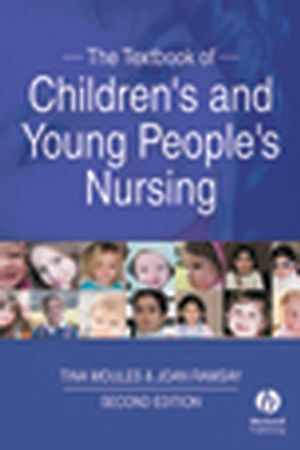The Textbook of Children's and Young People's Nursing, 2nd EditionISBN: 978-1-4051-7093-2
Paperback
800 pages
December 2007, Wiley-Blackwell
 |
||||||
Module 1: Understanding families.
Introduction.
1. The family.
2. Roles and relationships.
3. Functions of the family.
4. Child-rearing practices.
References.
Module 2: The growing child.
Introduction.
1. The nature of childhood.
2. Growth and maturation.
3. Theoretical perspectives -- cognitive development.
4. Theoretical perspectives -- the social world of the child.
5. Play and education.
References.
Module 3: Promoting child health.
Introduction.
1. Trends in child health.
2. Health.
3. Children’s perceptions of health.
4. Developing strategies for health.
5. Role of children’s nurses in child health promotion.
6. Aspects of health in childhood.
References.
PART 2: HEALTH AND DEVIATIONS IN CHILDHOOD.
Module 4: Understanding families in stress.
Introduction.
1. The influence of family stress upon the child.
2. Hospitalisation and illness.
3. Death and the family.
4. Chronic illness -- family stress and coping.
5. Living with a disability.
6. Violence in the family.
References.
Module 5: Principles of caring for sick children.
Introduction.
1. Hearing children’s voices in NHS service delivery and evaluation.
2. Creating an appropriate hospital environment for children.
3. Preparation for hospital and procedures.
4. Assessment of the sick child.
5. Day care.
6. Emergency care.
7. Administration of medicines.
8. Providing nutrition.
9. Maintaining fluid balance.
10. Caring for children in pain.
11. The role of the nurse as a surrogate.
12. Community nursing.
13. Pre- and post-operative care.
14. Aspects of paediatric intensive care.
15. Caring for the dying child and the family.
References.
Module 6: Specific care of sick children.
Introduction.
1. Principles of care -- children with blood disorders.
2. Principles of care -- children with problems of bones, joints and muscles.
3. Principles of care -- children with a circulatory disturbance.
4. Principles of care -- children with a metabolic or endocrine disorder.
5. Principles of care -- children with eye, ear, nose and throat disorders.
6. Principles of care -- the child with altered gastro-intestinal function.
7. Principles of care -- children with genito-urinary problems.
8. Principles of care -- children with problems related to the immune system.
9. Principles of care -- children with a neurological problem.
10. Principles of care -- children with altered breathing.
11. Principles of care -- children with skin disorders.
12. Mental health in childhood.
13. Care of the sick and preterm newborn.
14. Principles of care -- children undergoing cytotoxic treatment and radiotherapy.
15. Principles of care -- children and adolescents with problems related to sexuality.
References.
PART 3: PROFESSIONAL ISSUES IN CHILD CARE.
Module 7: The development and process of children’s nursing.
Introduction.
1. The history of children’s nursing.
2. Roles of the children’s nurse.
3. Models of nursing -- useless theory or an aid to practice.
4. Models of children’s nursing.
5. Family-centred care.
6. The nurse as a developing professional.
7. Children’s nursing in a multi-cultural society.
8. The future of children’s nursing.
References.
Module 8: Legal and ethical issues.
Introduction.
1. Consent to treatment.
2. Children’s Act 1989.
3. Confidentiality.
4. Research.
References.
Module 9: Managing professional practice.
Introduction.
1. Discharge planning.
2. The nurse as leader.
3. The organisation of patient care.
4. Standard setting and audit.
5. Work force allocation.
6. Risk management.
References.
Index



